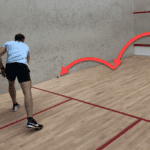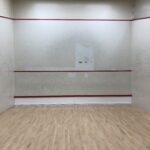This post may contain affiliate links.
Professional squash players seem to push their limits while controlling the ball using their racket, however not all ways to control the ball are allowed. Being somewhat fascinated by how I can push my own limits with racket control, I decided it was time to uncover those limits according to the squash regulations.
In squash, you cannot carry the ball, since you are not allowed to hit the ball more than once. This applies to both the serve and the return.
While the quick answer may be sufficient for some, it is worth clarifying the act of carrying including its benefits and drawbacks in greater detail. Besides, I will substantiate the conclusion using the official regulations.
What is carrying the ball in squash?

Before we can actually divide into the rules we need to define the term carrying. So what is carrying the ball in the squash realm?
A squash rally starts with a service where the first player drops the ball (out of their hand) and hits it with their racket towards the front wall. During the remainder of the rally, no player is allowed to hold the ball in their hands. Therefore actual carrying, meaning holding the ball in your hands, is not allowed.
However, in many racket sports, carrying the ball relates to someone juggling and balancing the ball on their racket before hitting. As a result, carrying usually involves the ball bouncing multiple times on the racket blade before the player would return the ball to the front wall.
To demonstrate the difference, a regular return involves swinging your racket and hitting the ball once before it leaves the racket blade. Having the ball touch the racket blade more than once while playing a return, might seem valuable. Therefore, let’s look at the potential benefits and drawbacks of carrying the ball in squash.
Potential benefits of carrying the ball
- Slow down the pace of the rally, especially when your opponent is putting you under pressure. This allows you to reposition yourself and maybe even catch your breath.
- Trick your opponent into moving already (especially when they are playing aggressively and opportunistically) and have the possibility to put the ball in a different part of the court. I find that incorporating unpredictability into your game is a great tactic. It even makes my top 10 tips on how to improve your return.

- Having a second attempt at controlling the ball, rather than directly trying to return the ball. Chances are, you are more likely to hit the ball perfectly when you have the time and ability to control it.
Potential drawbacks of carrying the ball
- Buying your opponent time to react or move to the T, the most dominant position on the court. This applies of course only when your opponent is observing you carefully.
- Limiting your ability to hit the ball with power, therefore limiting your options to return the ball. You can generate more power if you hit the ball directly, compared to carrying the ball. Therefore, if your opponent recognizes this in time, they are able to position themself strategically. As a consequence, they have an easy return and possibly win the point.
Now we know what carrying means in the realm of squash, as well as the potential benefits and drawbacks, let’s dive into the official squash rules.
WSF on carrying the ball
My first thinking was to check the WSF regulations and see if there is anything specific mentioned regarding carrying the ball. However, there is no specific rule mentioned in the Rules of Squash regarding this. But does this then mean that it is allowed?
The basic guideline for any rally is as follows: as long as the serve and returns are good, the rally continues.
To specify it even further, there are 4 criteria (that all need to be met) to determine whether the return is good:
- The ball is hit before it has bounced on the floor more than once.
- The ball hits the front wall on the playing part
 without bouncing on the floor and without hitting the opponent (including their racket and clothing)
without bouncing on the floor and without hitting the opponent (including their racket and clothing) - The ball returns from the front wall without hitting the tin

- The ball is not considered out
If you are looking for more than just an eligible return, check out this article on how to effectively return a serve .
.
Another basic guideline that slightly links to carrying the ball is the following: Play must be continuous as far as practical. Continuous play mainly relates to the time in between a rally. For example, it is unreasonable to example uninterrupted play for the whole match. Professional squash players push themselves to their limits, but in the end, they are not robots. Therefore some time is allowed between rallies in order for players to partially recuperate.
As of now, we assumed the rally was considered good by both players and the officials. Therefore the rally continues as long as each return is good, or until a squash player disagrees and either requests a let or makes an appeal. When a player requests a let or an appeal is made, the referee needs to make a decision. Another scenario where the rally stops is when one of the Officials makes a call, or the ball hits either player or their clothing or the non-striker’s racket.
PSA on carrying the ball
Does a lack of prescriptive rules around carrying the ball indicate that it is allowed? I was not so sure, so I checked other resources to find out. Luckily this search proved to be valuable in the end. According to the Professional Squash Association , it is not allowed to carry the ball. The reason is that you are not allowed to hit the ball more than once. Nevertheless, I am still struck by the fact that I did not come across this rule in the WSF rules.
, it is not allowed to carry the ball. The reason is that you are not allowed to hit the ball more than once. Nevertheless, I am still struck by the fact that I did not come across this rule in the WSF rules.



